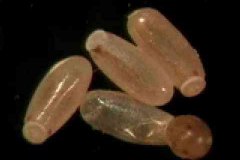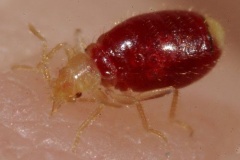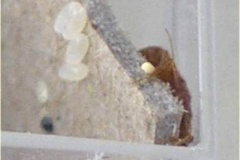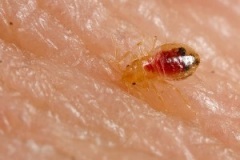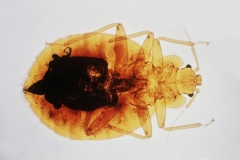Bedbug Information
A bedbug is a small, blood-sucking parasite that feeds on mammals and birds. Bedbugs belong to the insect family Cimicidae. Although there are several different species, the most common species associated with human bedbug infestations are Cimex lectularius and Cimex hemipterus. Bedbugs are considered a public health pest. There has been a recent resurgence in bedbug infestations worldwide, particularly in developed countries, including the United States.
Adult bedbugs are reddish brown in color, flat, oval-shaped, wingless and approximately 4-5 millimeters in length. Immature bedbugs (nymphs) may be translucent or light tan in color and therefore very difficult to see. Bedbugs are often more red in color after feeding. Bedbugs are attracted by warmth, and they generally feed during the night, often just before dawn. They tend to feed every five to 10 days, though they can survive without feeding for several months. Bedbugs pierce the skin and inject saliva that contains anesthetics and anticoagulants into the host, which often make their bites painless initially. After feeding on the host's blood for several minutes, bedbugs will crawl back to their hiding place. They will generally try to hide and remain within close range of their warm-blooded host. Affected individuals may feel and see the consequences of the bedbug bite afterward, though many individuals will not develop any physical signs of a bite. Bedbugs do not transmit or spread human disease.
What Causes a Bedbug Infestation? How Common Are Bedbugs?
Bedbugs are found in temperate and tropical climates worldwide. The insects are most commonly found in living quarters where their host resides. Bedbugs generally hide in the seams and crevices of bed mattresses and box springs, bed frames, headboards, upholstery, old furniture, closets, and in spaces underneath baseboards or behind loose wallpaper. Clutter and disarray also provide additional hiding places for bedbugs. Bedbugs may be transported from one location to another via luggage, furniture, clothing, and used mattresses. Although they are often associated with unsanitary living conditions, bedbug infestations also occur in clean, well-maintained living quarters, including five-star hotels and resorts. Bedbug infestations have been increasingly reported in hotels, dormitories, homes, apartments, nursing homes, cruise ships, shelters, jails, and hospitals. There have been several cases in the U.S. involving litigation because of infestations of bedbugs, and thus bedbugs are considered a public health pest by several agencies.
Prior to World War II, infestations of bedbugs were common; however, after the widespread introduction of the use of the insecticide DDT in the mid-20th century, bedbug infestations became much less common. The recent resurgence in infestations of bedbugs worldwide is thought to be related to several different factors, including the increase in international travel, dense urban living conditions, insecticide resistance, and new, ineffective pest control measures.
What Are Symptoms and Signs of Bedbug Bites?
The symptoms of a bedbug bite are usually mild when present, and often individuals will not experience any symptoms at all. Bedbug bites can occur on any exposed part of the body, with the face, neck, arms, and hands being areas commonly affected. The signs and symptoms can appear from minutes to days after the initial bite. Affected individuals will usually complain of localized itching and reddish-colored skin lesions, which may look like a flat welt or a raised bump. Sometimes, the lesions can be found in clusters or in a linear pattern. Typically, these skin lesions will go away after one to two weeks.
Individuals who experience repeated bites over time may have more pronounced symptoms. Some people may also develop scarring or a skin infection from intense scratching of the skin. Rarely, a more severe systemic allergic reaction to a bedbug bite may develop. Some individuals may develop insomnia and anxiety from serious or repeated bedbug infestations.
When Should Someone Seek Medical Care for Bedbug Bites?
The vast majority of the time, bedbug bites can be managed at home. However, if someone begins to experience any of the following symptoms, consult a health care professional or go to the nearest emergency department:
How Do Health Care Professionals Diagnose Bedbug Bites?
The diagnosis of a bedbug bite can sometimes be difficult, as bedbug bites may appear similar to the bites of other insects. A health care professional will ask detailed questions and perform a physical exam, focusing on the skin. Other organ systems will also be examined to assess for any signs of an allergic reaction or for signs of infection. No blood tests or imaging studies will be necessary. If someone is able to bring in a specimen of the insect that may have bitten them, this can be helpful in making the diagnosis.
What Is the Medical Treatment for Bedbug Bites?
Medical treatment is usually not needed for bedbug bites. If required, medical treatment is aimed at relieving the symptoms (like itching) caused by bedbug bites. In the rare cases of a systemic allergic reaction or a secondary skin infection, evaluation by a health care professional may be necessary. Individuals may also want to seek medical care if they are unsure of what is causing their skin lesions.
What Are Home Remedies for Bedbug Bites?
Bedbug bites usually do not require any treatment. If you develop itching of the skin around the site of the bite, you can use an over-the-counter antihistamine pill or cream such as diphenhydramine (Benadryl). Some individuals may also experience relief from the itching by applying a hot washcloth directly to the affected area. Try to avoid scratching the skin, as this can cause skin breakdown and a subsequent secondary bacterial skin infection.
Are There Medications for Bedbug Bites?
Medications for bedbug bites are usually not necessary. As noted above, over-the-counter antihistamine pills or creams (diphenhydramine) may be used for the itching. Corticosteroid creams (hydrocortisone) applied to the affected area may also be helpful for some individuals.
If a secondary bacterial skin infection develops, an antibiotic ointment or an oral antibiotic may be prescribed by a health-care professional.
Rarely, in cases of a severe systemic allergic reaction, injections of epinephrine, antihistamines, and corticosteroids may be required.
Is Follow-Up Needed for Bedbug Bites?
Follow-up with a health care professional may be necessary after a systemic allergic reaction or to monitor an individual's progress if they have developed a secondary bacterial skin infection. Otherwise, follow-up with a health care professional is usually not necessary.
Is It Possible to Prevent Bedbug Bites?
The best preventive measure against bedbug bites is to avoid situations that may give rise to bedbug infestations. There are several measures that can be undertaken to prevent bedbug infestations, including
If someone suspects a bedbug infestation, try to detect and confirm their presence.
First, make sure that the suspected bugs are bedbugs, because other insects or arthropods such as a carpet beetle, scabies mite, a bat bug, louse, or other bugs may be mistaken for bedbugs. If there is confirmation of a bedbug infestation, several measures can be taken to help control or eradicate the infestation, using both nonchemical and chemical (insecticides) methods. It can take several weeks to months to achieve complete eradication of a bedbug infestation, and it may take several treatment cycles to completely eliminate them. In many cases, it will be necessary to hire a pest control service in order to implement a comprehensive extermination strategy.
The following do-it-yourself tips may help if you have an infestation of bedbugs:
For travelers and renters, exposure to potential bedbugs can also be prevented by visiting the Internet public database of user-submitted bedbug reports in the U.S. and Canada at the Bedbug Registry.
What Is the Prognosis for Bedbug Bites?
The prognosis for bedbug bites is excellent. The vast majority of people who experience bedbug bites will recover without any long-term problems, and many individuals who are bitten may not exhibit any physical signs at all. However, the recent resurgence in bedbug infestations will require increasing public education and awareness, instituting effective preventive and control measures, and continuing research into the development of more effective, safe insecticides.
Reviewed on 9/11/2017
REFERENCES:
United States. Centers for Disease Control and Prevention. "Parasites -- Bed Bugs." May 24, 2016. <https://www.cdc.gov/parasites/bedbugs/index.html>.
United States. Environmental Protection Agency. "Bed Bugs: Get Them Out and Keep Them Out." May 4, 2017. <http://www.epa.gov/bedbugs>.
Read more:
How To Get Rid of Bedbugs: Pictures, Symptoms, and Signs

 Residence
Residence  Location
Location 

